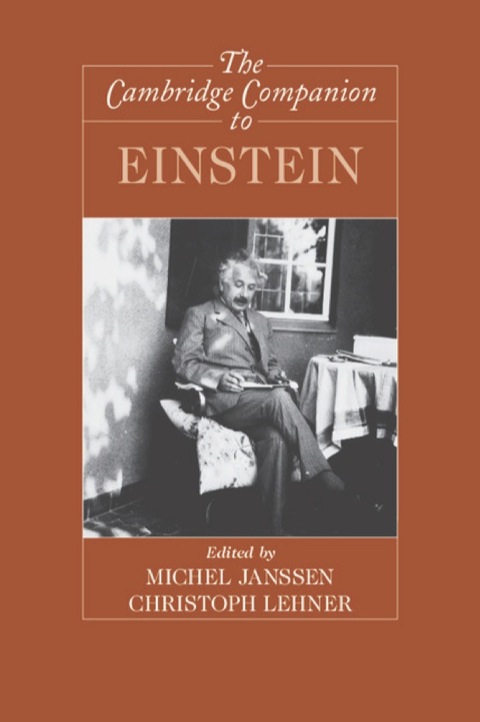Description
Efnisyfirlit
- Half-title
- Frontispiece
- Series information
- Title page
- Copyright information
- Dedication
- Table of contents
- List of contributors
- Preface
- Introduction
- Notes
- 1 Einstein’s Copernican Revolution
- 1. Introduction
- 2. Einstein as a Disciple of Boltzmann, Planck, and Lorentz
- 3. The Origins of Einstein’s New Perspective
- 4. Speculative Alternatives to Classical Physics
- 5. Statistical Mechanics as a Bridge between Classical and Modern Physics
- 6. The Reinterpretation of Classical Physics
- 6.1. The Light Quantum Hypothesis
- 6.2. Brownian Motion
- 6.3. Special Relativity
- Notes
- 2 Einstein’s Special Theory of Relativity and the Problems in the Electrodynamics of Moving Bodies
- 1. Introduction
- 2. Basic Notions
- 2.1. Einstein’s Postulates
- 2.2. Relativity of Simultaneity
- 2.3. Kinematics of Special Relativity
- 3. Lorentz’s Theorem of Corresponding States
- 3.1. Failing to See the Ether Wind
- 3.2. A Challenging Problem in Electrodynamics
- 3.3. The Theorem
- 4. Einstein’s Path to Special Relativity
- 4.1. The Magnet and Conductor Thought Experiment
- 4.2. Field Transformations and the Relativity of Simultaneity
- 4.3. Einstein Considers an Emission Theory of Light
- 4.4. Return to Maxwell’s Theory
- 4.5. Stellar Aberration
- 5. E = mc2
- 5.1. The Result
- 5.2. A Demonstration
- 6. Conclusion
- Acknowledgments
- Notes
- 3 Einstein on Statistical Physics: Fluctuations and Atomism
- 1. Introduction
- 2. The First Two Papers: 1901–1902
- 3. The Year 1905
- 4. Foundations of Statistical Physics, 1902–1904
- 5. Critical Opalescence
- Notes
- 4 The Quantum Enigma
- 1. Introduction
- 2. Max Planck on Black-Body Radiation
- 3. Einstein’s Statistical Mechanics
- 4. The Revolution of 1905
- 5. Quantized Oscillators
- 6. Conversions to the Quantum
- 7. Waves and Corpuscles
- 8. Three Years of Skepticism
- 9. Back to the Quanta
- 10. Crucial Experiments
- 11. Quantum Degeneracy and Matter Waves
- 12. Conclusion: Einstein and Quantum Mechanics
- Notes
- 5 The Experimental Challenge of Light Quanta
- 1. Introduction
- 2. The Photoelectric Effect and Beyond
- 3. Classical Theories of the Photoelectric Effect
- 4. Millikan’s Experiments and Theory
- 5. The Compton Effect
- 6. The Bohr-Kramers-Slater Theory
- Notes
- 6 “No Success Like Failure …”: Einstein’s Quest for General Relativity, 1907–1920
- 1. Introduction
- 2. First Attempt: The Equivalence Principle
- 3. Second Attempt: General Covariance
- 4. Third Attempt: A Machian Account of Newton’s Bucket
- 5. Fourth Attempt: Mach’s Principle and Cosmological Constant
- 6. PostMortem: How Einstein’s Physics Kept His Philosophy in Check
- Acknowledgments
- Notes
- 7 Einstein’s Role in the Creation of Relativistic Cosmology
- 1. Introduction
- 2. The Great Debate
- 3. Relativistic Cosmology
- 3.1. Paradoxes of Newtonian Cosmology
- 3.2. Mach’s Principle
- 4. Cosmological Models: A Versus B
- 4.1. The Many Faces of Model B
- 4.2. Singularities
- 4.3. Redshift
- 5. The Expanding Universe
- 6. Conclusion
- Acknowledgments
- Notes
- 8 Einstein, Gravitational Waves, and the Theoretician’s Regress
- 9 Einstein’s Unified Field Theory Program
- 1. The Conceptual Dimension
- 2. The Representational Dimension
- 3. The Biographical Dimension
- 4. The Philosophical Dimension
- Notes
- 10 Einstein’s Realism and His Critique of Quantum Mechanics
- 1. Introduction
- 2. Einstein’s Realism
- 3. Einstein’s Determinism
- 4. The Rise of Quantum Mechanics
- 5. The First Debates about Quantum Mechanics
- 6. The Entanglement Argument
- 7. Macroscopic Realism
- 8. Epilogue: Einstein’s Dream Shattered?
- 9. Why Einstein Did Not Like Quantum Mechanics
- Acknowledgments
- Notes
- 11 Einstein and the Development of Twentieth-Century Philosophy of Science
- 1. Introduction
- 2. Background and Early Influences
- 3. A New Empiricism as an Answer to the Neo-Kantians
- 4. Not a “Machian,” But Not a “Realist” Either
- 5. Conclusion
- Notes
- 12 “A Believing Rationalist”: Einstein and “the Truly Valuable” in Kant
- 1. Introduction
- 2. What Did “the Problem of Gravitation” Teach?
- 3. “The Truly Valuable” in Kant
- 4. Einstein’s Kant
- 5. Projecting the Order of Nature
- 6. Conclusion
- Notes
- 13 Space, Time, and Geometry
- 1. Introduction
- 2. Einstein, Schlick, and Poincaré
- 3. Einstein’s Introduction of Non-Euclidean Geometry and the Nineteenth-Century Tradition
- 4. Morals for Twentieth-Century Philosophy of Geometry: From Space to Space-Time
- Notes
- 14 Einstein’s Politics
- 1. Introduction
- 2. Background and Youth: Making a Virtue of Necessity
- 3. Crosscurrents of the Early Career
- 4. Convergence with the World: Distilling Political Positions out of Moral Concerns
- 5. Recovering Judaism: Einstein’s Version of Zionism
- 6. Achieving Social Justice: The Social Democratic Solution
- 7. The Flexible Pacifist
- 8. Einstein in America: The Nonpartisan Champion of the Underdog
- Notes
- Appendix: Special Relativity
- 1. The Relativity Postulate, the Light Postulate, and Their Strange Consequences
- 1.1. The Two Postulates of Special Relativity and the Tension between Them
- 1.2. The Relativity of Simultaneity
- 1.3. Time Dilation: The Rate of Moving Clocks and Other Processes in Systems in Motion
- 1.4. Length Contraction: The Length of Moving Rods and Other Objects in Motion
- 1.5. The Addition of Velocities
- 2. Special Relativity and Minkowski Space-Time
- 2.1. Minkowski or Space-Time Diagrams
- 2.2. Relativity of Simultaneity: Different Observers Carving Minkowski Space-Time into Different Sim
- 2.3. Tachyons, Causal Loops, and Causal Paradoxes
- 2.4. Time Dilation and Length Contraction: Different Observers Using Different Line Segments to Dete
- 2.5. Euclidean Geometry and the Geometry of Minkowski Space-Time
- 2.6. The Analogue of the Pythagorean Theorem in Minkowski Space-Time
- 2.7. The Twin Paradox
- Notes
- Bibliography
- Index






Reviews
There are no reviews yet.